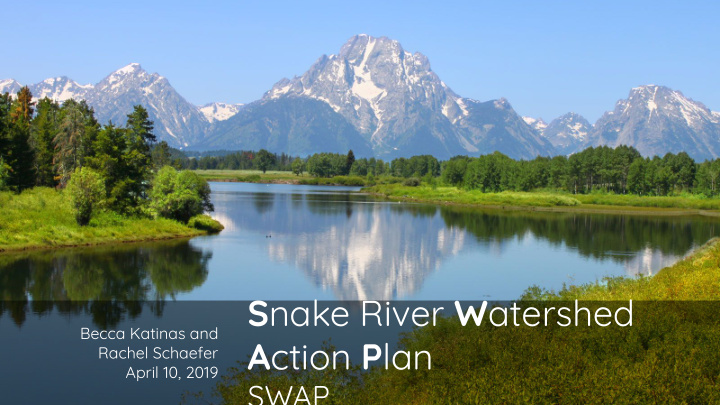



S nake River W atershed Becca Katinas and A ction P lan Rachel Schaefer April 10, 2019 SWAP
Mission Statement The goal of SWAP is to improve the water quality in the Snake River Watershed, which stretches from western Wyoming, southern Idaho, and eventually empties in Washington, by 50%. SWAP aims to ensure that the Snake River Watershed meets CWA standards by 2040 and residents can use the water to drink, swim, fish, and enjoy various recreational activities.
Columbia River Watershed ● Columbia River highlighted in purple ● Snake River highlighted in yellow ○ Partially along Idaho-Oregon border
Background ● Wyoming, Utah, Nevada, Idaho, Oregon, Washington ● 109,000 square miles (282,000 square meters) drainage basin ● Elevations: 10,000 feet (3,000 meters) to 300 feet (90 meters) ● Length: 1,040 miles (1,670 kilometers) ● Largest tributary of Columbia River ● Named after Shoshone (“Snake”) Indians by 1812 ● History of many dams along river and its tributaries competing with fishing industry
Policies ● New 3-year agreement on lower four dams ○ Made in 2018 between 3 federal agencies, Oregon & Washington officials and the Nez Perce Tribe based on NOAA studies ○ Keep dams, increase spill, protect salmon ● Snake River Compact 1949 - Idaho and Wyoming shares bordering area of Snake River 96% - 4% ● Clean Water Act
Problem 1: Nutrients and runofg decrease river water quality ● Agricultural runoff from farms and ranches ● Concentrated animal feeding operations in Idaho ● Animal manure ● Nitrogen and phosphorus pollution ● Weakening regulations ● Lack of Clean Water Act participation
Problem 2: Debris and waste dumped or washed into river make it dangerous to use ● Litter and junk found in river (slot machines, fishing line, tire, metal) ● Combined with high turbidity in many parts ○ 2015 USACE dredging project ○ Diving for removal ● Broken sewer lines and septic tanks ○ Leaching into groundwater Dredge turbidity monitoring buoy
Problem 3: Dams along the river inhibit fish passage and habitat while providing hydroelectricity ● 4 USACE lower Snake River dams block natural salmon and steelhead migration ● Stagnant reservoirs, higher water temperatures ● ~1,000 MW average (3,000 MW maximum) ● Important irrigation source ● Orca dependence on salmon ● Increased spill ● Costs of replacement/removal
Goals and Recommendations of Snake River Watershed Action Plan ● Monitor nitrogen and phosphorus concentrations and work toward 85% of watershed has levels below maximums ○ Partner with farmers and business owners on proper practices ● Clean up and remove at least 70% debris from the watershed ○ Improve sediment control to reduce turbidity and help divers ● Retrofit, remove, or seal broken septic tanks and sewer lines ● Improve fish passage along the Snake River ○ Add fish ladders ○ Remove dams (replace with renewable energy)
References “Dams, Projects and Powerplants.” United States Bureau of Reclamation , 6 Dec. 2016, https://www.usbr.gov/pn/snakeriver/dams/index.html. Accessed 3 Apr. 2019. Eaton, Nate. “What’s in the Snake River? Slot machines, cars, bodies, tractor wheels and a whole lot more.” KSL Broadcasting . Desert Digital Media, 17 Sept. 2018, https://www.ksl.com/article/46392407/whats-in-the-snake-river-slot-machines-cars-bodies-tractor-wheels-and-a-whole-lot-more. Accessed 3 Apr. 2019. Flatt, Courtney. “To Help Orcas Catch More Salmon, Washington Plans To Increase Spill At Dams.” Oregon Public Broadcasting , 30 Jan. 2019 https://www.opb.org/news/article/washington-salmon-fish-orca-spill-dams/. Accessed 3 Apr. 2019. NOAA Fisheries West Coast Region. “Fish Ladders.” NOAA Fisheries West Coast Region , 21 Sept. 2012, www.westcoast.fisheries.noaa.gov/fish_passage/about_dams_and_fish/fish_ladders.html. Probert, Cameron. “Opponents call new dam agreement to help salmon ‘worse than useless.’” Tri-City Herald , 18 Dec. 2018, https://www.tri-cityherald.com/news/local/article223256350.html. Accessed 3 Apr. 2019. “Snake River.” American Rivers , 2017, https://www.americanrivers.org/river/snake-river/. Accessed 3 Apr. 2019. “Snake River.” Encyclopædia Britannica, Inc . Edited by Amy Tikkanen, 2019, https://www.britannica.com/place/Snake-River. Accessed 3 Apr. 2019. “Snake River.” National Park Service , United States Department of the Interior, 30 July 2015, https://www.nps.gov/yell/learn/nature/snake-river.htm. Accessed 3 Apr. 2019. “Snake River Basin.” Wyoming State Water Plan . Wyoming Water Development Office, n.d., http://waterplan.state.wy.us/basins/snake/issues.html. Accessed 3 Apr. 2019. “Water Quality.” Snake River Waterkeeper , 2017, https://www.snakeriverwaterkeeper.org/water-quality/. Accessed 3 Apr. 2019. “Why Remove the 4 Lower Snake River Dams?” Save Our wild Salmon , 2019, https://www.wildsalmon.org/facts-and-information/why-remove-the-4-lower-snake-river-dams.html##2. Accessed 9 Apr. 2019.
Recommend
More recommend